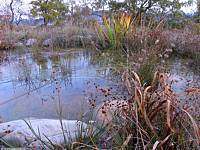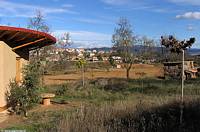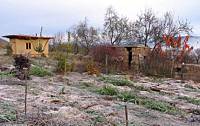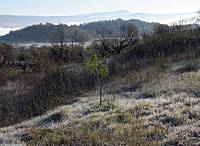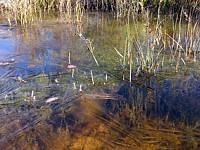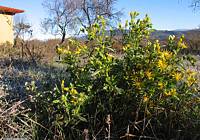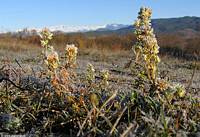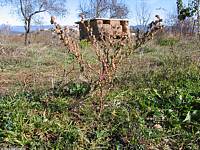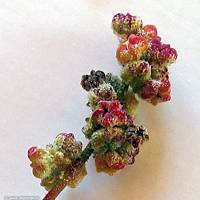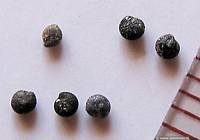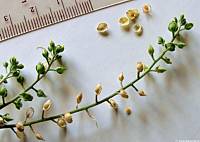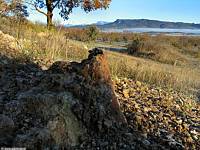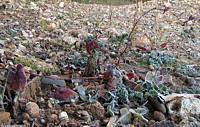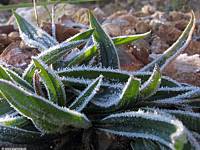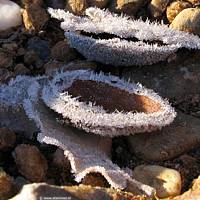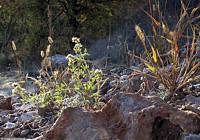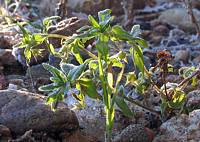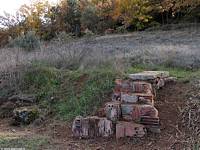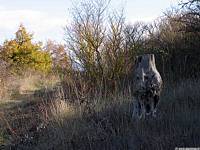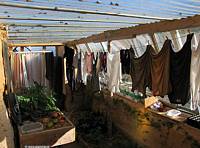|
|
Nature
Switched On
in the Pyrenees the first 10 years |
|
|
|
introduction |
2010 November 16 to 25 On 17 November there was for the first time a
decent ice layer on the upper pond. Not comparable to the one
exactly 3 years ago;
the autumn is Most of the leaves of the deciduous trees have fallen but
there are notable exceptions, not only between species but also
between individual plants. This is the case with the Black mulberry trees that were planted last year. They usually turn yellow
in autumn and that was what they did last autumn. But this year 2 of
them showed withered leaves turning dark brown while the third one
maintained a surprisingly fresh green colour. To make things even
more curious, this third one was the first to shed its, still
green, leaves! One of the most colourful autumn leaves showed the Cherry tree near the compost heap, while the Quince tree is still holding all its green leaves as if it were high summer.
Not a tree, not even a vascular plant but still fresh green under an ice layer in the pond, is the macro alga Chara connivens.
|
Upper pond. |
|
|
On the right the Mulberry tree with withered leaves, left from
the centre the one with green leaves. Looking east. 18 Nov 14:51 |
|||
|
On the right the red colours of
the Cherry tree, on the left in front of the house the green Quince
tree. 19 Nov 8:52 |
|||
|
The green young Almond tree with at the back the old trees of the
neighbour without leaves. Looking south-east. 25 Nov 9:44 |
|||
|
The green underwater jungle of Chara connivens. 25 Nov 9:38 |
|||
|
Not only leaves but also a surprising number of flowers is still active. Here a visual roundup of some of these brave stayers.
|
|||
| A
relatively low but flower-rich Senecio jacobaea. Looking north. 24 Nov 9:21
|
A heroic attempt to flower in
spite of the frost. Reseda phyteuma. 24 Nov 9:17
|
||
| Newly
introduced in the floristic catalogue, this all too common
Capsella bursa-pastoris is, growing between the rocks of the
'grey water'
pond. 24 Nov 13:10 |
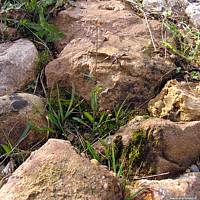 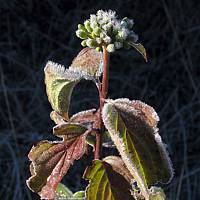 |
All of its namesakes have shed
their leaves but this specimen even tries to develop some flowers. Cornus sanguinea. 25 Nov 9:55
|
|
|
Erigeron acer usually combines fructifying with new waves of
flowers. Northern terrace, looking east. 18 Nov 14:32
|
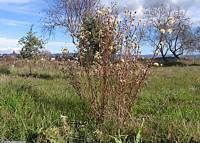 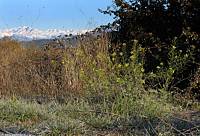 |
Erucastrum
nasturtiifolium flowers
almost all year round. Looking north-east. 24 Nov 9:14 |
|
|
Almost without any leaves but with many flowers and/or fruits is this Chenopodium species that grows in several areas. I suppose it is Chenopodium album (White goosefoot) which was previously detected in the zone. The relatively smooth skin of the seed points in the same direction.
Growing massively
together, Alyssum alyssoides (on the right) might
give a yellow glow over a field but this specimen grew all alone and
its flowers are almost undetectable. By the way, this Alyssum species is also a mayor constituent of the green roof vegetation where it graciously fills up the spaces among the Sedum species. |
|||
|
Chenopodium album with only some small stipules. Looking east. 24 Nov 12:04 |
|||
| 5 fleshy
parts of the perianth cover the fruit of Chenopodium species. The white spots have nothing to do with frost: they are specialized hairs with vesicles filled with water as an adaptation against drought. 24 Nov 12:13 . |
Black seed with a relatively
smooth skin points to Chenopodium album. 24 Nov 12:44
|
||
|
A new episode from the rock corner. Not
much growth of course these days, more a question of decay and
struggle to survive. Nevertheless the
|
|||
|
The same Fallopia convolvulus from the anterior episode is
clearly having difficulties with the frost.
Two frozen Almond shells. |
Compliment or disapproval? At
least a remarkable statement, stirring more than only the visual
sense. 25 Nov 9:16
|
||
|
Struggling against frostbite but it produced at least 3
pea-like fruits. |
Another flowering Reseda
phyteuma (left) between what remains of the Setaria pumila
flowers. 25 Nov 9:30 |
||
|
A stairway to the next terrace. It will be nice to follow the
colonization of plant and wild life in the crevices. 18 Nov 14:41 |
LeRoy is still a mayor source of inspiration for the management of the zone and his influence is clearly visible in this stairway recently built with debris, but this time I started to build after watching a recent documentary about Anselm Kiefer, with the suggestive title Over Your Cities Grass Will Grow. His latest projects are really of (eco-)cathedral proportions.
On the same debris dump I found this old Olive trunk. |
||
|
Old Olive trunk on the central terrace. Some earth was put into its hollow bowels. 25 Nov 14:13 |
|||
|
Another function was added to the
solar greenhouse (in
the best permaculture tradition where one system preferably
exercises a couple of |
Solar energy is used as
the electricity source for the washing machine, as a way to heat the
washing water and as a way to dry the laundry. Fortunately the
climate is quite sunny over here.
|
||
|
introduction
|
|
||
